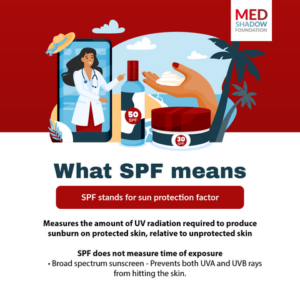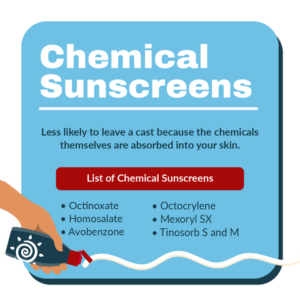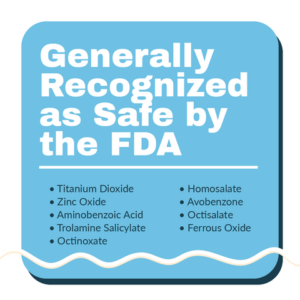 We all know we’re supposed to wear safe sunscreen daily to prevent sunburns, premature aging and skin cancer, though many of us fall short of reaching that goal. Some reasons we forgo the creamy protection are that we don’t think we’re at risk, we don’t like the greasy lotion, we don’t like its smell or we aren’t happy about the the white, or even purple, cast it can leave on our skin. But those aren’t the only reasons to choose carefully. While using sunscreen regularly is crucial to preventing skin cancer, some sunscreen ingredients can do more harm than good. Here’s what you need to know.
We all know we’re supposed to wear safe sunscreen daily to prevent sunburns, premature aging and skin cancer, though many of us fall short of reaching that goal. Some reasons we forgo the creamy protection are that we don’t think we’re at risk, we don’t like the greasy lotion, we don’t like its smell or we aren’t happy about the the white, or even purple, cast it can leave on our skin. But those aren’t the only reasons to choose carefully. While using sunscreen regularly is crucial to preventing skin cancer, some sunscreen ingredients can do more harm than good. Here’s what you need to know.
The Two Types of Sunscreen
The short answer to finding a safe sunscreen is, believe it or not, to use relatively small amounts. That doesn’t mean going outside unprotected. It does mean choosing instead long sleeves and pants and wide-brimmed hats that can block the sun on most of your skin and then applying sunscreen to the areas that are still exposed and vulnerable to the sun’s rays.
Every summer, people search for “spray sunscreen,” the super-convenient easy-to-apply sunscreen that comes in aerosolized bottles. Over the past few years, however, experts have raised concerns about both the safety and efficacy of these and other forms of chemical sunscreens. In summer 2019, searches for “mineral sunscreen,” which have been touted as safer alternatives, closed the gap and surpassed searches for “spray sunscreen” in the US.
As for safety data on potential side effects, reef safety in the oceans and overall efficacy, mineral sunscreens usually outperform chemical sunscreens, which come in both spray and lotion forms.
Physical and Mineral Solutions
Physical sunscreens use two different minerals approved by the Food and Drug Administration (FDA), zinc oxide and titanium dioxide, to prevent the sun’s rays from penetrating your skin. These minerals sit on the skin’s surface and physically block the UVA (ultraviolet A) and UVB (ultraviolet B) rays from damaging it, hence the term “physical sunscreen.” (Note: the name “physical sunscreen” does not imply that the lotions are free of chemicals; all sunscreens contain chemicals.)
Fayne Frey, MD, a dermatologist and founder of educational website FryFace.com, says, “The zinc oxide protects more of the UVA range than titanium dioxide. So sometimes you’ll see sunscreens that have just zinc oxide. You rarely see ones that have just titanium dioxide.”
A common complaint about these sunscreens is that they leave white or purple streaks or tints on the skin, especially on dark skin. These casts can appear even more pronounced if the skin gets wet. Kemunto Mokaya, MD, a dermatologist in Houston, recommends using tinted versions of sunscreens to minimize the issue.
Chemical in Safe Sunscreen
 Chemical sunscreens, explains Frey, “sit on the skin. They absorb the heat and make a chemical reaction, which releases heat. And that doesn’t allow the ultraviolet light to get into the skin.” The problem with chemical sunscreens is that, in recent years, scientists have found that the chemicals themselves can seep into your body through the skin, and it’s not fully known how each chemical might affect the body.
Chemical sunscreens, explains Frey, “sit on the skin. They absorb the heat and make a chemical reaction, which releases heat. And that doesn’t allow the ultraviolet light to get into the skin.” The problem with chemical sunscreens is that, in recent years, scientists have found that the chemicals themselves can seep into your body through the skin, and it’s not fully known how each chemical might affect the body.
FDA’s Stance on Safe Sunscreen Ingredients
Below is a list of active ingredients that the FDA allows in sunscreens today. Allowing these ingredients in sunscreen formulas does not mean that they have been deemed completely safe.
 Avobenzone
Avobenzone
Cinoxate
Dioxybenzone
Homosalate
Meradimate
Octocrylene
Octinoxate
Octisalate
Oxybenzone
Padimate O
Ensulizole
Sulisobenzone
Titanium Dioxide *mineral block
Zinc Oxide *mineral block
Sunscreens are reviewed by the FDA as cosmetics rather than drugs. The agency designates certain active ingredients as Generally Recognized as Safe and Effective (GRASE) or not GRASE. As data has shown that the chemicals used in chemical sunscreens can enter the body through the skin and breath, and linger there, in 2019, the FDA announced that it would be requesting more information from manufacturers about how these ingredients interact with the body before determining if they are safe for use.
Several ingredients, including oxybenzone, which is found in many chemical sunscreens, are not only capable of being absorbed through the skin, but also can act as endocrine disruptors. One 2019 study suggested that if enough oxybenzone enters through a pregnant woman’s skin, it has the potential to affect the neural development of her fetus. Endocrine disruptors interfere with the functioning of the glands and organs in our bodies that release hormones responsible for guiding our growth, development, metabolism, reproduction and more.
In the same year, the FDA announced that the only two substances considered to be GRASE for sunscreens were zinc oxide and titanium dioxide, the minerals found in physical sunscreens. It suggested that two chemicals, aminobenzoic acid (PABA) and trolamine salicylate, were unsafe. For all the rest, the agency maintains it needs more information before making a decision.
The FDA had intended to issue decisions about these ingredients’ safety in 2019, but, according to the Environmental Working Group (EWG,) the FDA’s proposal was withdrawn from the first coronavirus relief bill. However, the agency plans to propose new regulations this fall.
What SPF Does and Doesn’t Tell You
The most ubiquitous identifier of sunscreen’s efficacy, the sun protection factor (SPF) is often misunderstood. There are two types of UV rays that can damage our skin: UVA rays and UVB rays. A sunscreen’s SPF only gives you information on its ability to block UVB rays, which are thought to cause the most sunburns. However, Beth Goldstein, MD, at Central Dermatology Center says, “UVA penetrates deeper into the skin, into the dermis and suppresses the immune system of the skin and promotes cancer.” That’s why it’s crucial to look not only for a sunscreen’s SPF rating, but also for its “broad-spectrum” label. “Broad spectrum sunscreen implies that it prevents both UVA and UVB rays from hitting the skin,” adds Goldstein.
Adrienne Haughton, MD, brings up another issue with SPF ratings. The SPF label on the bottle doesn’t always match what’s inside, she says. Independent testing from Consumer Reports has found that nearly half of sunscreens don’t provide even half of the SPF their labels claim. For this reason, she suggests wearing a higher SPF sunscreen than you may need.
Sunscreens for Sensitive Skin or Other Conditions
Both Goldstein and Frey say if you have sensitive skin, your best bet is to go with a mineral sunscreen. The chemicals that penetrate your skin in chemical sunscreen are more likely to irritate your skin, exacerbate rosacea, eczema or acne and the heat from the chemical reaction itself can also irritate skin, explains Goldstein. “The chemical blockers can actually flare rosacea.”
Still, some people prefer chemical blockers since they tend to be easier to rub into the skin and less likely to leave white or colored streaking. If you have sensitive skin, but still prefer these sunscreens, Frey suggests that you test the product first by putting a little on the back of your ear or arm to make sure you don’t have a reaction to it, before applying it on your face or the rest of your body.
It’s not just the active ingredients in sunscreens that can cause skin irritation and allergies. Since 1994, researchers have found that methylisothiazolinone, a preservative used in some sunscreens and other cosmetics to prevent bacterial and fungal growth is frequently the culprit behind allergies and skin irritation. When the rash-causing preservative gained attention again in 2014, some companies started removing it from their products. However, many products still contain the ingredient.
Cover That Skin Up
“The best sunscreen is the one you use, use liberally, often and really put it on. Most people in everyday conditions don’t use enough sunscreen,” says Frey. Even better than slathering on sunscreen daily, every two hours when you’re in the sun, “the safest thing is just to seek shade, wear a hat and stay covered,” says Haughton. You can also minimize your use of sunscreen by wearing UV-protective clothing and, of course, wide-brimmed hats.
When applying sunscreen, it takes more than you think to get optimal protection. You need a shot glass full for your body and a teaspoon for your face. TikToker Maren Reed shows how much she uses to cover her face, arms and hands.
@marentreedReply to @bondenavant #sunscreenqueen hope this clears everything up (: xoxoxo♬ original sound – Maren Reed
Remember, while wearing sunscreen limits the damage the sun can do to your skin, it doesn’t eliminate it. “If you’re laying out the sun with sunscreen on,” adds Goldstein, “there’s only so much that sunscreen is going to do for you.”






